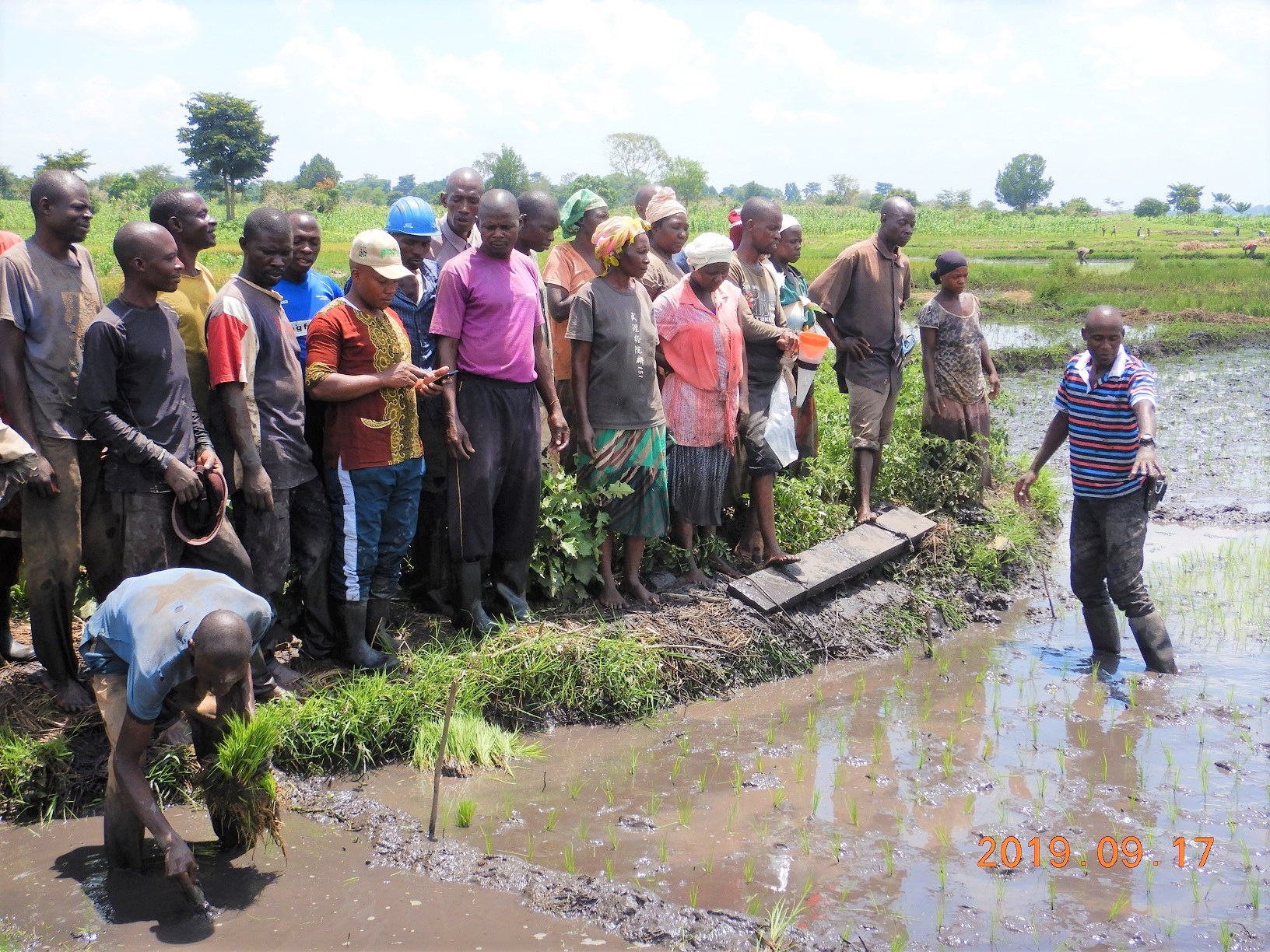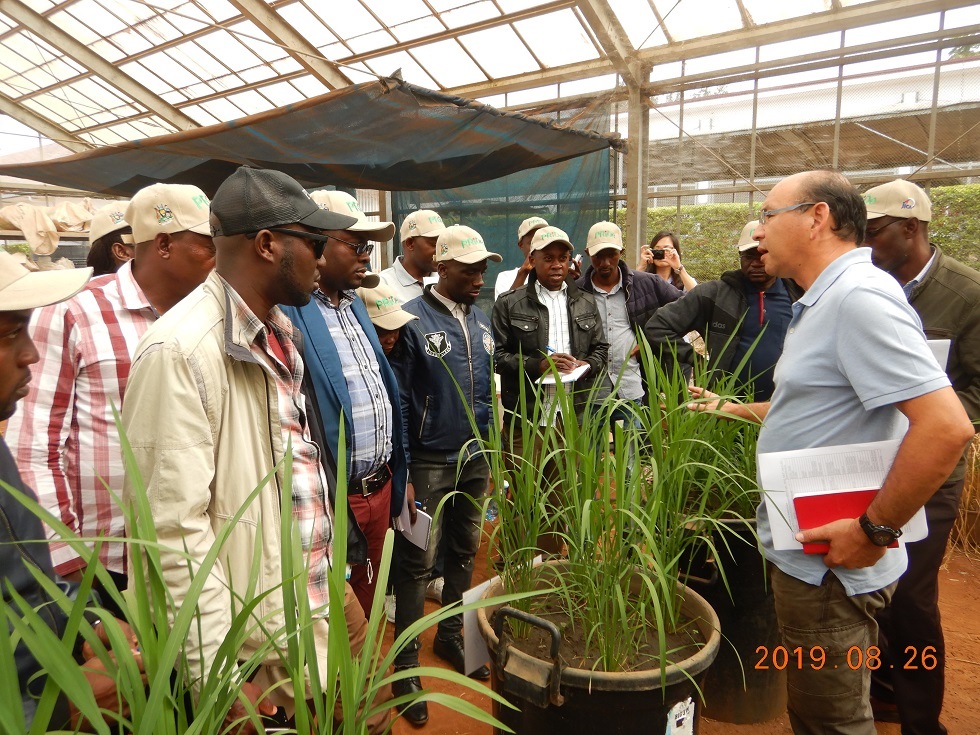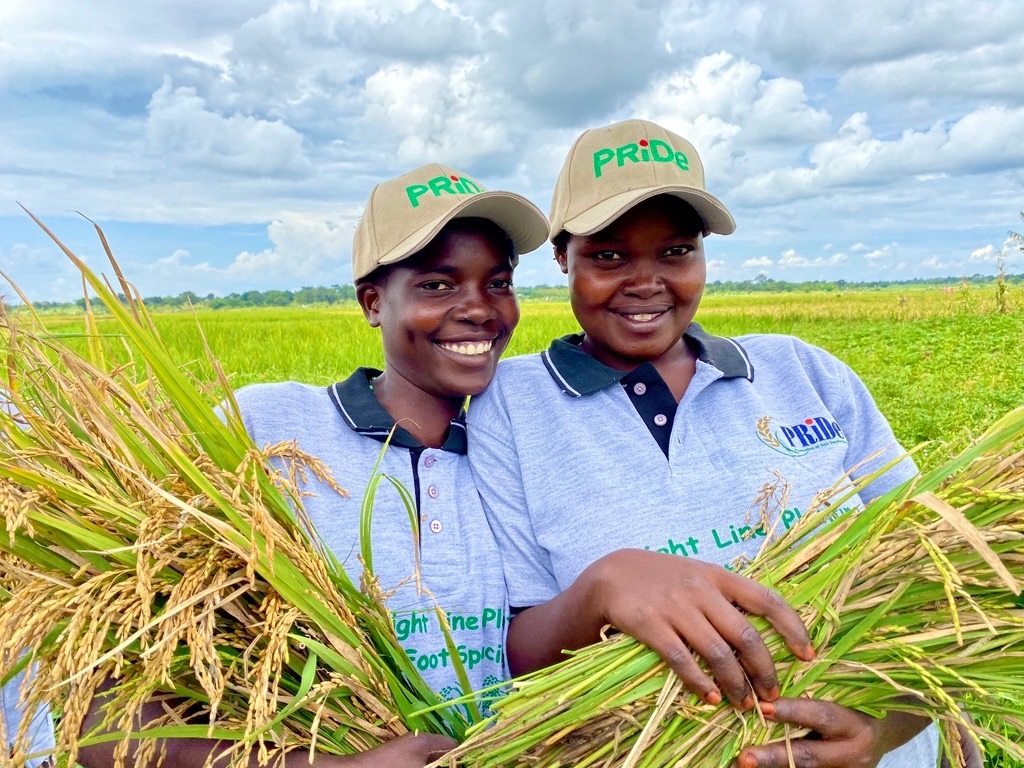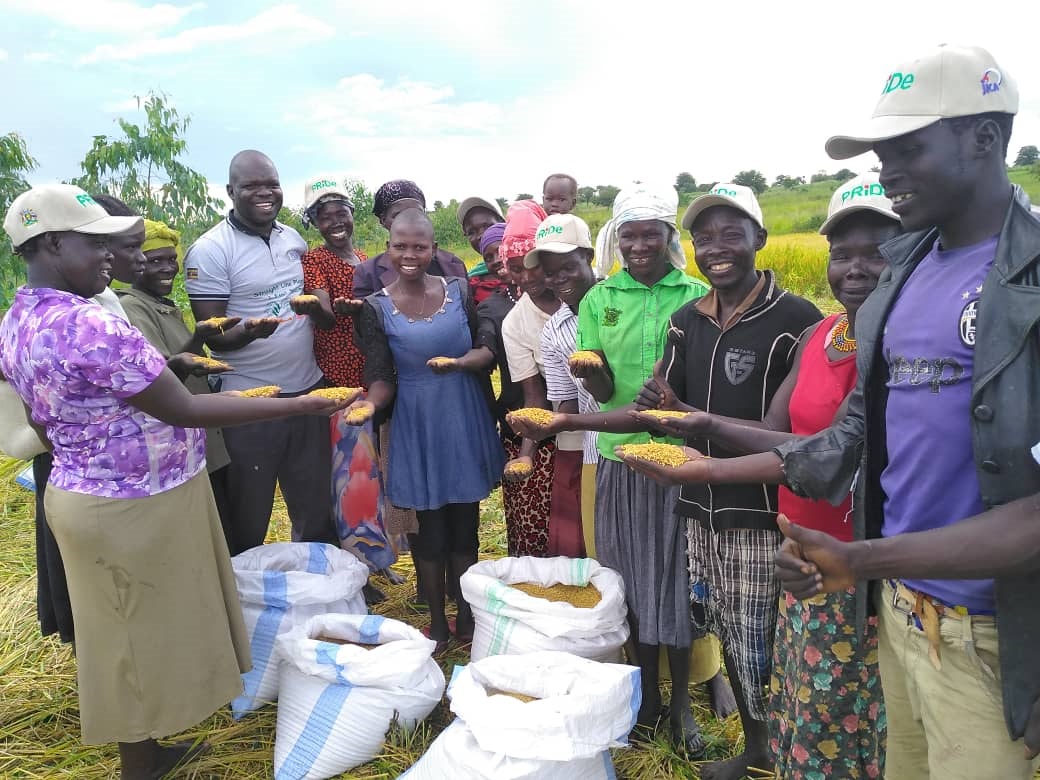The ACDP Project
THE AGRICULTURE CLUSTER DEVELOPMENT PROJECT
The Agriculture Cluster Development Project (ACDP) is a partnership project of the Ministry of Agriculture, Animal Industry and Fisheries and the World Bank, financed by the International Development Assistance (IDA) of the World Bank.
The Project was declared effective on January 23, 2017.
Project Development Objective (PDO)
To raise on-farm productivity, production, and marketable volumes of selected agricultural commodities (maize, beans, rice, cassava and coffee), in specified (12) geographic clusters (spanning over 57 districts).
The project is hinged on the following components:
COMPONENT 1: Support for Intensification of On-Farm Production
Subcomponent 1.1: e-voucher program
Subcomponent 1.2: Capacity Building for Target Beneficiaries
Subcomponent 1.3: Support development of Agricultural Input markets
COMPONENT 2: Value Addition and Market Access
Subcomponent 2.1: Capacity Building for Producer Organizations and other Value Chain Actors
Subcomponent 2.2: ACCE-level Warehousing, Value addition and Marketing
Subcomponent 2.3: Farm Access Roads and Choke Points at Community Level
COMPONENT 3: Policy, Regulatory and Institutional Support
Subcomponent 3.1: Policy and Regulatory Functions
Subcomponent 3.2: Agricultural Water Management Investments
Subcomponent 3.3: Agricultural Statistics
Subcomponent 3.4: Fall Army Worm Management
COMPONENT 4: Coordination and Management, and ICT Platform
Subcomponent 4.1: National, Cluster and District Coordination
Subcomponent 4.2: Monitoring and Evaluation and Impact Evaluation
Subcomponent 4.3: Web-based, Geo-tagged ICT Platforms.
The project is aligned to the key Agriculture Sector objectives as contained in the Agriculture Sector Strategic Plan (ASSP) and the National Development Plan II (NDP II). Its components operationalize three sector specific objectives of:
- To increase production and productivity of agricultural commodities and enterprises;
- To increase access to critical farm inputs;
- To improve access to markets and value addition and strengthen the quality of agricultural commodities, and;
- To strengthen the agricultural services institutions and enabling environment.
Brief on progress to date
The Agriculture Cluster Development Project (ACDP) has been effective for 27 months, during which it underwent a second tier-two restructuring that is currently being implemented; the first restructuring was in amendment to the project effectiveness conditions in November 2016. The performance rating over the effectiveness period has for the most part been ‘unsatisfactory’, fetching the project the undesirable status of a ‘problem project’. The fourth Implementation Support Mission of November 2018 upgraded the project performance rating to ‘Moderately Satisfactory’, marking the beginning of significantly positive change. This report covers the cumulative progress since the start of the current Financial Year (FY) 2018/2019.
In fiduciary terms, the performance has improved from an expenditure level of USD 7,604,931= as of December 2018, to USD 10,227,127.8= as at end of March 2019. This is a 34% change on the previous performance level, representing 6.8% of the USD 150,000,000= World Bank International Development Association (IDA) credit financing.
The key physical performance and progress in component one pertains to the Electronic Voucher Management System (EVMS). Following the EVMS launch in Kalungu district in November 2018, up to 12,950 farmers have been enrolled onto the system – these have paid their commitment fees, which also double as an initial deposit on the inputs. Information, Extension & Communications (IEC) materials on the EVMS, Financial Literacy and Agro-input use were developed, and subsequently 3,988 farmers in the pilot districts have been trained. The first set of 679 farmers that received inputs in Kalungu district in Season 2018B represented the first positive change in the Project Development Objective key performance indicator on number of direct project beneficiaries. This indicator now stands at 3,530.
Summary of the Electronic Voucher Management System

Initially, three (3) National Agro-inputs dealers, for fertilizers, pesticides and post-harvest materials and equipment were pre-qualified, but now there are 29 agro-dealers that have been accredited and enrolled. In the farmer registration activity, an additional 49,553 farmers in 3,459 Farmer Groups have been registered, in the 13 ‘rollout districts’ of Masaka, Mpigi, Rakai, Kyotera, Bugweri, Bugiri, Namutumba, Gulu, Kabale, Bushenyi, Isingiro, Arua and Yumbe. This brings the total registered farmers to 87,272.
The Launch of the E-Voucher system by Hon. Vincent Bamylangaki Sempijja, the Minister for Agriculture, Animal Industry and Fisheries
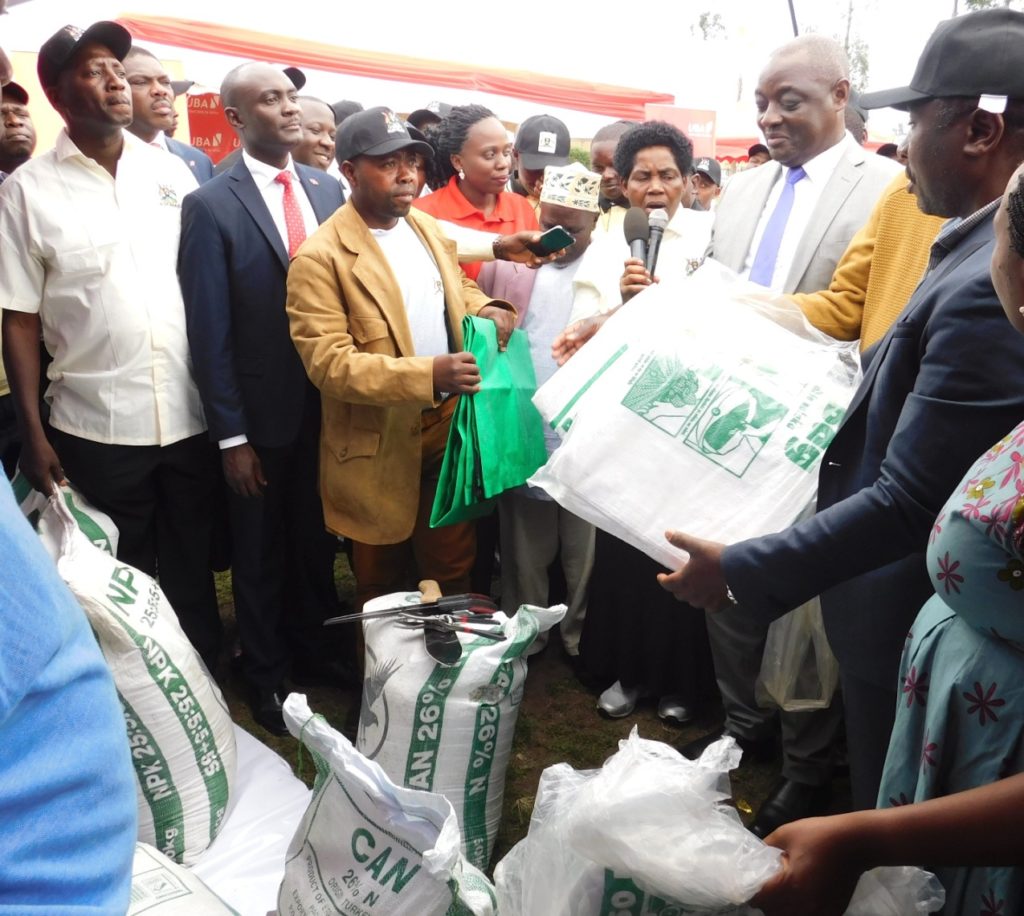
In the second project component, the objective is to enhance value addition and market access, by supporting farmer organisations to improve post-harvest handling and processing, and fund the rehabilitation of rural access roads critical for the movement of farm produce to markets. Thus far, Matching Grant guidelines have been developed, and up to 95 farm road chokes along 254 km of road were prioritized for rehabilitation in the five pilot districts, these include: 23 chokes in Kalungu (29.3km), 21 chokes in Ntungamo (54.1km), 23 chokes in Iganga (59.7km), 14 chokes in Amuru (56.6km) and 14 chokes in Nebbi (54km). The road designs and bills of quantities for the pilot districts were developed and finalised in May 2019. Mapping of high production areas in the 37 rollout districts has been concluded.
The new component three was restructured to institute supportive frameworks for key MAAIF functions. These include policy formulation and regulatory functions for agro-inputs and mechanization, and studies on Water for Production; Agricultural statistics; and capacity to manage the Fall Army Worm infestation. In the first instance, the project supported the development of the Plant Protection and Health Regulations, and Guidelines governing certification of vegetatively propagated planting materials.
Prefeasibility studies for 18 potential sites were concluded but the procurement of a consultancy firms to undertake the feasibility studies and detailed engineering designs, and for Environmental and Social Impact Assessment (ESIA) for 5 selected irrigation schemes in Iganga (Lumbuye, Block A and Block B), Bugiri (Bukagolo), Amuru (Ayila), and Nwoya (Aswa), were re-initiated due to a technicality in the procurement process, and now the process is at request for Expressions of Interest, with a closing date of May 14, 2019.
Of the 30 sites identified as potential for demonstrating smallholder coffee irrigation, drafting of detailed designs for 15 sites has been concluded. Under Agricultural Statistics, a survey has been conducted to establish the quality of agro-inputs on the market, in the project areas with preliminary statistics. To combat the Fall Army Worm (FAW), the Department of Crop Protection and the National Agricultural Research Organisation (NARO) undertook surveys and laboratory studies on the diversity and efficacy of key potential bio-control agents for the Fall Army Worm.
Component 4 finances the incremental operating costs for the Project Coordination Unit, Cluster Multi-Stakeholder Platforms and District Coordination Teams. These include coordination, monitoring, evaluation and development and implementation of web-based, geo-tagged ICT platforms for learning, knowledge management and stakeholders’ feedback. To address environmental and social concerns in the project areas, 244 Grievance Redress Committees were established in the participating sub counties of the 5 pilot districts. The project baseline survey is underway, with the first draft report due in May 2019. The PIM was reviewed and a draft M&E Manual produced.
The Project Grievance Redress Mechanism
As a way of ensuring that challenges which arise during the implementation of the Agriculture Cluster Development Project (ACDP) are met with timely solutions, a Grievance Redress Mechanism and a toll-free number (08001000030) were put in place by the project team.
Here is what you need to know from the Grievance Redress Mechanism in brief:
Why is the Grievance Redress Mechanism important?
The publication describes a number of mechanisms for addressing complaints arising out of the project interventions and provides avenues of addressing complaints that may emerge over time during project implementation. The overall intention is to address community concerns, reduce risks, and assist other processes to create positive impact.
Who is involved in resolving grievances and providing solutions?
The GRM was designed with a committee at every level with one at village level that is chaired by the LC2, one at sub-county level chaired by the LC3 Chairperson, another at District Level chaired by the LC5 Chairperson and the Project team at the Ministry of Agriculture, Animal Industry and Fisheries.
Who can make use of the publications about the Grievance Redress Mechanism?
The guidelines can be used by individuals and organizations involved in the management of grievances and complaints arising from project implementation. Examples of such groupings include; grievance focal persons, Ministry staff, grievance redress committees, hired consultants and contractors, trainers, academicians, and civil society organisations.
What are some of the foreseen grievances during the course of the Agriculture Cluster Development Project?
1. Irrigation schemes – might lead to resultant conflicts in relation to land use, damage on people’s livelihoods, loss of wetland habitat, downstream users may have issues in relation to water abstraction.
2. Road civil works – attachment on cultural resources, sexual harassment, exploitation, child abuse, corruption, HIV/AIDS, child labour, violence
3. Conflicts over ownership of rice fields or wetlands and/or communal access for other uses such as grazing, watering animals, harvesting papyrus for making mats, fishing etc.
4. Conflicts over water resources
5. Issues of livestock grazing and watering in rice fields infrastructure
6. Issues related to compensation and restoration of barrow pits
7. Distribution of agrochemical inputs
8. Location of community access roads and farm roads.
Districts per Cluster Distribution

Farmers and other stakeholders in the project locations are advised to make use of the toll free number and respective offices to ensure smooth and inclusive implementation of the Agriculture Cluster Development Project.
Eligibility:
To benefit from ACDP, a farmer should:
- Be a member of a registered farmer association/cooperative.
- Be Ugandan and in possession of a valid National Identity card
- Be willing to commit at least one acre of the land for the project commodity
- Be willing to co-fund purchase of inputs.
Districts Covered by the Project
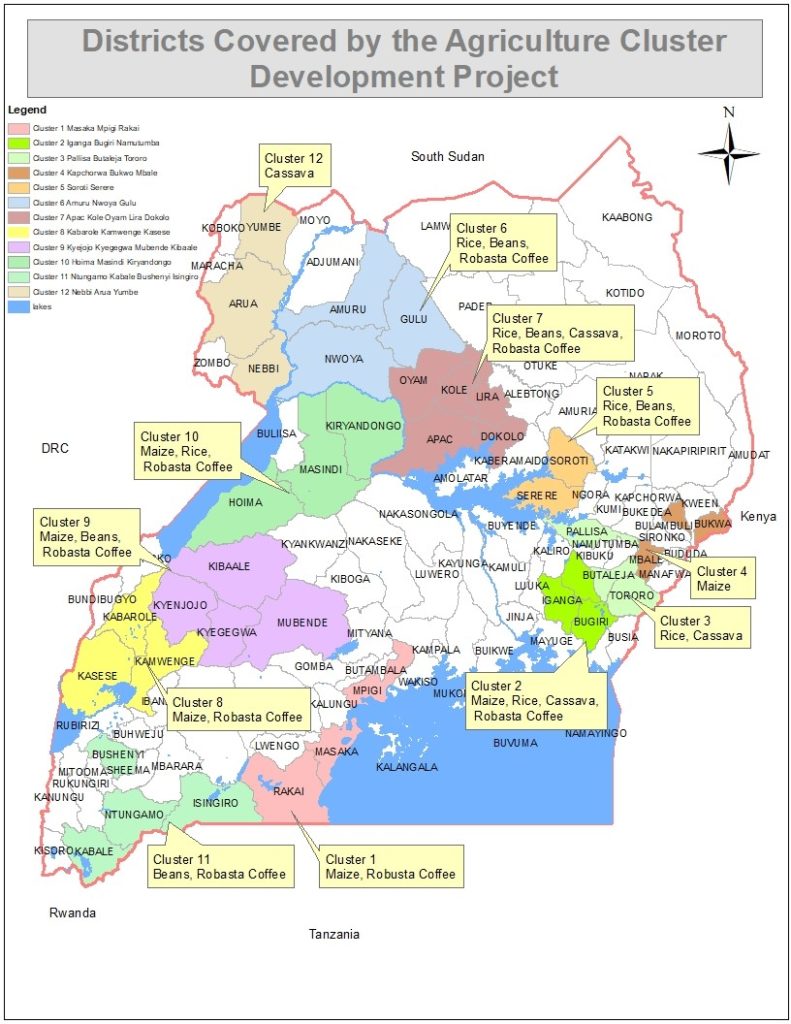
Other projects
- National Oil Palm Project Uganda
- NUFLIP PHASE 1
- The UMFSNP project
- Banana Livelihood Diversification project
- Uganda-China Cooperation
- The ACDP project
- The VODP2
- The ENRP project
- The ATAAS project
- The PISD project
- The RPLRP project
- The MOBIP project
- The Goat Export Project
The Uganda Multi-sectoral Food Security and Nutrition Project (UMFSNP) is implemented, over a period of five years, by the Government of Uganda (GoU) through the Ministry of Agriculture, Animal Industry, and Fisheries (MAAIF) working in a multi-sectoral collaboration with the Ministry of Health (MoH) and the Ministry of Education, Science Technology and Sports (MoESTS)
This project helps to support vulnerable communities in Western Uganda to better adapt to the effects of climate change (CC) through banana value addition activities, to provide greater opportunities for income generation, poverty reduction and food security
The Government of the Republic of Uganda and the Government of the People’s Republic of China have had a cordial relationship for a long time. China has made significant contributions to Uganda’s Agricultural sector development including provision of project aid to Uganda in form of interest-free loans and grants. Notable ones include the Kibimba and Doho rice schemes, Wakawaka Fish landing site, Kajjansi Aquaculture Training Centre, Hydropower Stations and Road Construction. Trade has included leather, coffee, fish and food products among others.
The Ministry of Agriculture, Animal Industry and Fisheries (MAAIF), with support from the World Bank is implementing the Agriculture Cluster Development Project (ACDP). The project arose from the need to implement the Ministry’s comprehensive plan to operationalize the Agriculture Sector Development Strategy and Investment Plan 2011/12 – 2014/15 (now Agriculture Sector Strategic Plan 2015/16 – 2019/20) and in line with the Uganda National Development Plan.
Uganda imports 60-70% of its edible and soap needs; Population growth and rising incomes continue to fuel an annual growth rate of 9% in domestic and regional demand for vegetable oil and its by-products. VODP 2 is Uganda’s strategic effort and increase domestic vegetable oil production, address rural poverty by involving smallholder farmers in oil crops production and improve the health of the population through increased vegetable oil intake.
The project is expected to increase production and productivity, mainly of small holder rice farmers, by focusing on those factors that currently limit production which include;
In 2010, the ATAAS project was developed as an investment in maintaining and raising the level of farmer productivity and household income through the development and adoption of modern farming technologies, techniques and strengthening market linkages. The project had key activities along the research-extension-farmer-market value chain continuum under five components: (1) Developing Agricultural Technologies and Strengthening the National Agricultural Research System (NARS); (2) Enhancing Partnerships between Agricultural Research, Advisory Services and other Stakeholders; (3) Strengthening the National Agricultural Advisory Services (NAADS); (4) Supporting Agribusiness Services and Market Linkages; and (5) Program Management and Coordination.
The Ministry of Agriculture, Animal Industry, and Fisheries (MAAIF) and Japan International Cooperation Agency (JICA) agreed to execute a study for Irrigation Scheme Development referred to as The Project on Irrigation Scheme Development in Central and Eastern Uganda (PISD) through technical cooperation.
The focus was on establishment of medium and large scale irrigation scheme in Uganda targeting farmers cultivating mainly rice in lowland areas with season flooding and unreliable agricultural water source(s). The Study has was entrusted by JICA to the JICA Study Team consists of a consultant from Japan in collaboration with counterpart staffs from MAAIF and MWE. A total of 10 candidate sites districts were studied for irrigation development potential in the districts of Butambala, Buikwe, Kween, Sironko, Bukedea, Bulambuli, Mbale, Butaleja, Budaka and Soroti..
The Regional Pastoral Livelihoods Resilience Project (RPLRP) is a regional project financed by a USD 40 Million loan got by GOU from the World Bank and implemented by three IGAD member states: Uganda, Kenya and Ethiopia.
The RPLRP was prepared within the framework of the IGAD Drought Disaster Resilience and Sustainability Initiative (IDDRSI) and aligned with the Regional Programming Paper (RPP) and Country Programming Paper (CPPs).
Uganda Vision 20140 is a key strategy document for the government of Uganda (GOU) and aims to make Uganda a middle-income country by 2040. The National Development Plan II (NDP2) mentions the development of the livestock sector as one of these strategies, and in particular Uganda’s ability to produce some of the best beef in Africa.
Project Objectives
“To enhance the contribution of the goat industry to farmers’ income and welfare.”
Specific objectives
Avail improved indigenous and exotic (Savannah) goat germplasm to farmers in the project area which will serve as a springboard for establishing a pilot goat export zone in the country
To establish open nucleus breeding herds coupled with systematic cross breeding programme for generating meat goat types for fattening and
Improve the goat management systems and create sustainable supplies of quality goats for internal and export markets.


